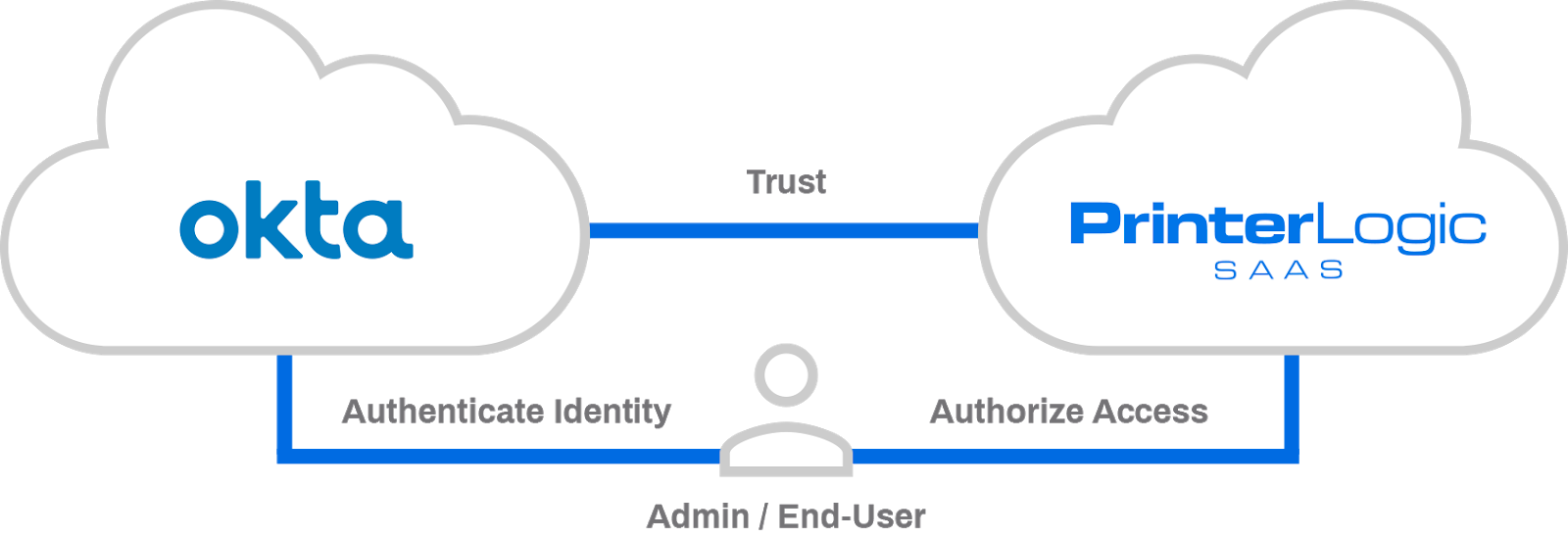ST. GEORGE, Utah, March 31, 2020—PrinterLogic, the world leader in Serverless Printing Infrastructure (SPI), today announced a new integration with Okta, the leading independent provider of identity for the enterprise. This integration allows IT professionals to eliminate print servers and identity-related infrastructure by connecting the Okta Identity Cloud into PrinterLogic SaaS for SCIM provisioning and single sign-on (SSO). As an Okta embedded partner, PrinterLogic customers can leverage secure and seamless access to centralized identity management through Okta’s authentication technology.
As more organizations adopt a cloud-first strategy, traditional on-prem identity management options such as AD are no longer optimal. Identity Providers (IdP), such as Okta, empower customers to centralize administration across cloud-based applications, improve security, and reduce infrastructure. By embedding the Okta Identity Cloud into PrinterLogic, it solves a common challenge faced by organizations trying to uncouple the many processes connected with AD, including printer management and deployment. In addition, the embedded integration allows PrinterLogic customers who would like to try Okta to connect their instance of PrinterLogic for free through the Okta Cloud Connect program.
“This partnership makes so much sense. Our customers love eliminating print servers, and Okta’s customers love removing legacy identity infrastructure,” said Garrett Helmer, SVP Channels, PrinterLogic. “Together we will empower IT professionals to deliver on their cloud-first initiatives and give end-users the easiest and best printing experience, managed in the cloud.”
The PrinterLogic embedded integration has passed rigorous testing by Okta, and is now included in the Okta Integration Network of verified and approved Okta applications. PrinterLogic is the only embedded integration partner to enable Okta customers to fully eliminate print servers by provisioning a centrally managed direct IP environment that is truly SaaS-based and integrates with their existing Okta Identity Cloud solution.
“At Okta, we’re on a mission to enable every organization to seamlessly integrate and securely use any technology, said Maureen Little, Vice President of Technology Partnerships, Okta. “By bringing together industry leaders in identity and access management and serverless printing infrastructure, we are able to deliver a disruptive and modern solution for enterprise print management to our customers. The integration of the Okta Identity Cloud with PrinterLogic enables organizations to cut another cord to their legacy infrastructure.”
The integration with Okta builds on PrinterLogic’s mission to be the world leader in serverless printing infrastructure and to support organizations of every size and environment in their digital transformation journey. PrinterLogic and Okta’s integration is available today.
For more information, visit: http://www.printerlogic.com/idp or https://www.okta.com/integrations/printerlogic-saas/
About PrinterLogic
PrinterLogic helps IT professionals eliminate all print servers and deliver a highly available
serverless printing infrastructure. With PrinterLogic’s centrally managed direct IP printing
platform, customers empower their end users with mobile printing, secure release printing, and
many advanced features that legacy print management applications can’t provide. The company
has been included multiple times on the Inc. 500 and Deloitte Fast 500 lists of fastest growing
companies in North America.

